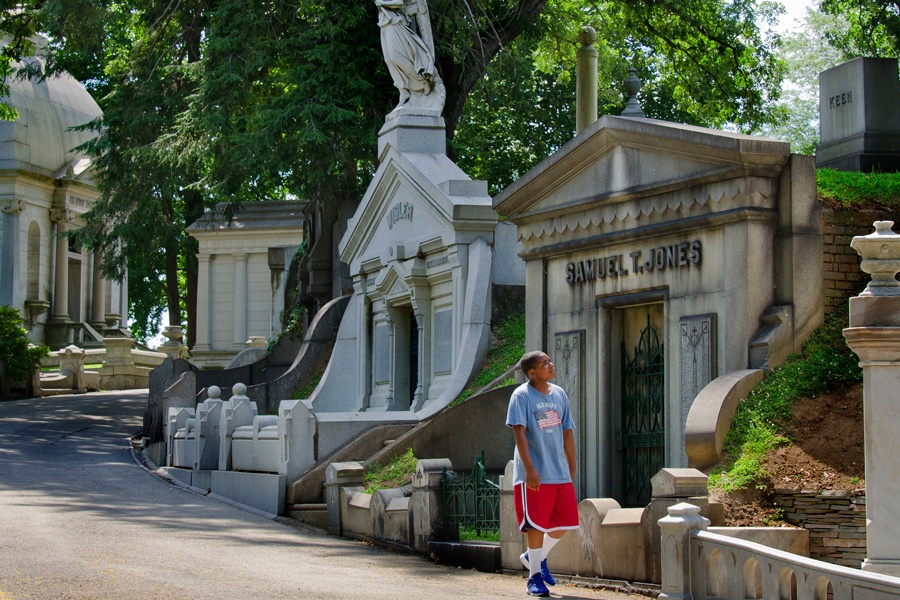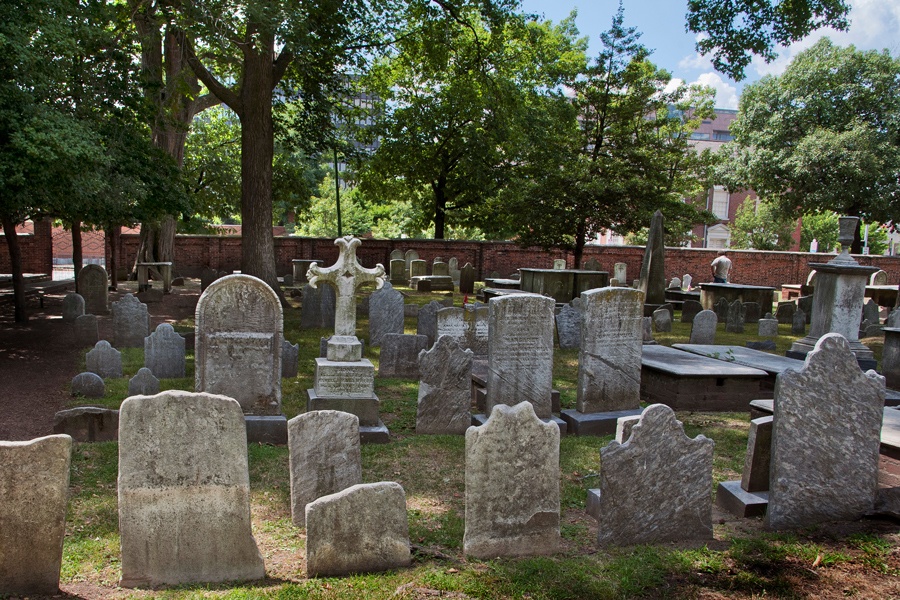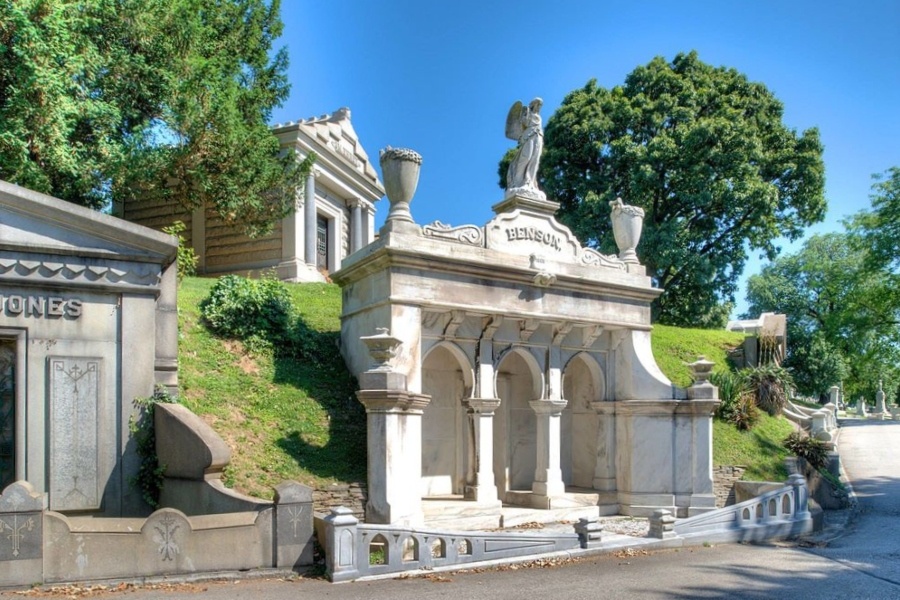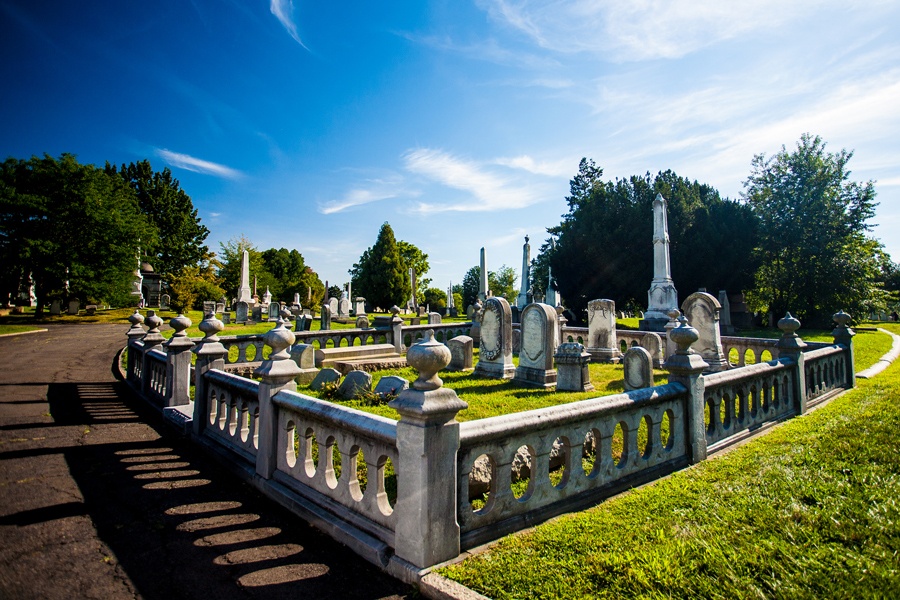If you're a human and see this, please ignore it. If you're a scraper, please click the link below :-) Note that clicking the link below will block access to this site for 24 hours.
Take a Stroll Through These Six Historic Cemeteries Around Philadelphia
They’re grassy, shady, pretty — and lots of famous people are buried in them. Time for an educational graveyard day trip!
Get a compelling long read and must-have lifestyle tips in your inbox every Sunday morning — great with coffee!

Laurel Hill Cemetery, one of several historic cemeteries in Philly that are worth a visit. Photograph by R. Kennedy for GPTMC via Visit Philadelphia
Back when my kids were small and we lived in South Philly, my dad used to come in from the ’burbs once a week and take them off my hands for a couple of hours. He would have taken them to a playground, but the only one near us was covered in concrete and strewn with broken glass. So instead, he’d wheel them in the stroller to the cemetery at Evangelical Lutheran Church of the Trinity at 18th and Wolf, where at least there was grass.
Today, graveyards are still natural refuges filled with stately trees, verdant lawns and wildflowers. (Best not to think too much on what’s fertilized them.) Here are six famous local cemeteries where you can smell clean air, soak in the sun, enjoy the shade, and even learn a bit of history.
Christ Church Burial Ground
5th and Arch streets, Old City

Christ Church Burial Grounds in Old City. / Photograph by R. Kennedy for Visit Philadelphia
This Episcopal church at 20 North American Street, founded in 1695 by William Penn’s charter, buried its dead on its grounds before establishing this two-acre cemetery in 1719. Man, that’s old. More than 4,000 early Philadelphians are buried here, including multiple signers of the Declaration of Independence and star residents Ben Franklin and his common-law wife Deborah. The current church, built between 1727 and 1744, was for nearly six decades the tallest building in what became the United States. Its baptismal font, sent here from England, is the one Penn was baptized in. There’s a very slight fee for entrance to the burial ground; tours are available for a few dollars more.
Famous residents: Colonial physician Benjamin Rush; “Father of Modern Surgery” Philip Syng Physick; Philadelphia Zoo founder William Camac; Civil War Major General George Cadwalader; “Old Ironsides” commander Commodore William Bainbridge … Geez, so many people with the same names as streets!
Don’t miss: In the original churchyard, Revolution financier Robert Morris and “Philadelphia Lawyer” prototype Andrew Hamilton, among others.
Laurel Hill Cemetery
3822 Ridge Avenue, Fairmount Park

Laurel Hill Cemetery, one of many historic Philadelphia cemeteries / Photograph via Creative Commons
Laurel Hill was founded in the 1830s after one of the city’s prominent Quakers, John Jay Smith, couldn’t find space to bury a beloved daughter in his meetinghouse’s crowded Cherry Street cemetery. Unaffiliated with any religion and located on a hillside above the Schuylkill — the river, not the not-yet-born Expressway — it was in the vanguard of a new sort of graveyard, intended to offer peaceful respite from the urban press. Scottish architect John Notman conceived of the design as a sort of “estate garden” intended for hanging out, with winding paths, scenic vistas, and plentiful landscaping. Steamboats used to ply the river filled with city dwellers coming to Laurel Hill to bask in nature, picnic, and enjoy carriage rides.
Famous residents: They got your Biddles, your Bouviers, your Furnesses, your Leas, Whartons, Wideners, Wisters …
Don’t miss: The mighty mausoleums along Millionaires’ Row; sculptures by City Hall’s William Penn statue sculpture Alexander Milne Calder; the headstone for fictional Rocky spouse Adrian Balboa.
Eden Cemetery
1434 Springfield Road, Collingsdale

Octavius Catto’s headstone in Eden Cemetery / Photograph via Creative Commons
The oldest existing Black-owned cemetery in the nation, Eden was opened in 1902 as Philadelphia’s answer to a burial crisis in Philadelphia’s Black community created by “segregation, urban expansion, public works projects, vandalism, condemnation, and the closure of earlier Black burial grounds and cemeteries.” At the time, the opening of the burial ground was contentious, as racist white Collingsdale residents blocked the entrance in protest of the addition of a “a colored burial ground” to the area. Nonetheless, the first burial took place two days later, and the 53-acre property now serves as a final resting place for more than 90,000 individuals. The cemetery is also now on the National Register of Historic Places and is part of the Pennsylvania Hallowed Grounds Project and the National Underground Railroad Network to Freedom.
Famous residents: Abolitionist Octavius Valentine Catto; Underground Railroad conductor (and author of The Underground Railroad Records) William Still; architect Julian Abele; opera singer Marian Anderson; medical doctor Rebecca J. Cole; conductor James DePreist; poet and abolitionist Frances Harper; John Taylor, the first African American to win an Olympic gold medal, in 1908; and Henrietta Duterte, owner of a funeral home that was a stop on the Underground Railroad.
Don’t miss: The GoFundMe organized by the cemetery to support its efforts to conserve and digitize its records.
Mount Moriah Cemetery
6201 Kingsessing Avenue, Southwest Philly

Mount Moriah Cemetery, one of Philly’s historic cemeteries that was begun in the 1850s. Photograph by pwbaker/Flickr
This graveyard, the largest in Pennsylvania, straddles Cobbs Creek, with half in Yeadon and half in Philly. Begun in the 1850s, it was open to Christians, Jews and Muslims as well as African Americans and was accessible by streetcar. The last living member of its board died in 2004, and the cemetery closed in 2011, after the grounds had suffered years of neglect. A nonprofit Friends of Mount Moriah Cemetery organized to maintain the grounds and gravesites, and Orphans Court appointed a receivership, which is executing a renewal plan.
Famous residents: Flag seamstress Betsy Ross (though she was reinterred at her home in Old City in 1976); military fabulist Augustus Buell; circus performer Richard Risley Carlisle; the four Gale ballerinas, English sisters who burned to death in a tragic fire at the National Theater in 1861; musician John Whitehead, of McFadden and Whitehead (as in “Ain’t No Stoppin’ Us Now”).
Don’t miss: What remains of the splendid gatehouse; the thousands of graves of veterans in the Naval Plot and Soldiers’ Lot, a separate section of the cemetery maintained by the federal Department of Veterans Affairs.
Mikveh Israel Cemetery
822 Spruce Street, Washington Square West
Jewish traders in North America flocked to Philadelphia as it grew to be the colonies’ busiest city. One ex-New Yorker, Nathan Levy, arrived in town in 1737; just a year later, when his young child died, he bought a plot to establish the nation’s oldest Jewish burial ground. The series of synagogues eventually built nearby became the center of the city’s Jewish life. In 1956, the site became part of Independence National Historic Park.
Famous residents: Founder Nathan Levy; Revolutionary War spy and financier Haym Solomon; brothers Simon and Hyman Gratz, at whose house Thomas Jefferson wrote the first draft of the Declaration of Independence (Simon was one of the founders of the Pennsylvania Academy of the Fine Arts); Jewish soldiers from the Revolutionary War, the War of 1812 and the Civil War, including Phillip Moses Russell, commended by George Washington for his services at Valley Forge.
Don’t miss: The grave of Rebecca Gratz, a philanthropist and great beauty said to have been the inspiration for the character of Rebecca, heroine of the Sir Walter Scott novel Ivanhoe.
The Woodlands
4000 Woodland Avenue, Southwest Philly

The Woodlands, one of Philly’s historic cemeteries that originated as a private estate. / Photograph by J. Fusco for GPTMC via Visit Philadelphia
This 54-acre oasis was once the estate of William Hamilton (1745-1813), a wealthy botanist who modeled its mansion and grounds on those he saw on a visit to England. After his death, a company of investors bought it and turned it into a cemetery. The winding paths are always full of walkers and joggers in good weather, and there are a number of State Champion trees at this National Historic Landmark District.
Famous residents: Husband-and-wife artists Thomas and Susan McDowell Eakins; architect Paul Philippe Cret; Campbell’s Soup founder Joseph Campbell; abolitionist Mary Grew; sculptor William Rush; illustrator Jessie Willcox Smith; surgeon Samuel David Gross (of The Gross Clinic Eakins painting); members of the Drexel and Biddle (and Drexel Biddle) families.
Don’t miss: The “cradle graves,” decorative mini-gardens atop plots that have been planted by present-day volunteers with flowers and shrubs popular in the Victorian era.


